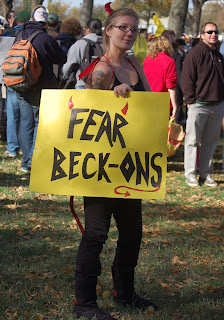



Funnymen Jon Stewart and Stephen Colbert have proven once more that “if you build it, they will come”.
At the start of the show Colbert said he was hiding in a “fear bunker” afraid no one would show up to Saturday’s “Rally to Restore Sanity and/or Fear” at the National Mall.


The crowd stretched from the foot of Capitol Hill to almost the Washington Monument.
Since the DC police and National Park service (which runs the Mall) stopped giving crowd estimates decades ago, they found another way of sizing up the event.


They asked people to carry a wave from the front rows to where the throng ended. The tsunami of raised hands and shouts rocketed through the Mall for almost a minute – perhaps offering a new form of measurement.





They also installed a seismograph and asked people to jump at the same time. We recalled an old belief that if China’s billions jumped together at the same time, they’d be able to simulate an earthquake.
The “minute-long” sized crowd jumped but experts say they “created” a tremor that was “200,000 weaker than a car colliding with a wall”. Well, so much for the China human earthquake theory.





The rally was very lighthearted, and most carried their own signs that tried to be creative, clever or funny – with “tried” mostly the operative word.
The rally called on Americans to turn their backs on hate and return to good old-fashioned civility – that seemed lost in the highly toxic political campaign season.






“This was not a rally to ridicule people of faith or people of activism…or to suggest that times are not difficult and we have nothing to fear,” Stewart said.
“They are and we do. But we live now in hard times, not end times,” he stressed, laying the theme of the day’s event.
It was a star-studded event that featured Sheryl Crow, John Legend, Yusuf Islam (formerly Cat Stevens) and Ozzy Osbourne, Kareem Abdul Jabar and R2D2, among others.




It looked like organizers and police underestimated the number of people attending the rally. There were not enough giant projectors or “Jumbotrons”, and speakers could not reach the crowd at the edges of the Mall.
People climbed up trees and lamp posts just to get a glimpse of, not the stage, but the “Jumbotrons”.



Many were evidently early Halloween revelers; others went to the rally to drive home a point.
They were just tired of the shouting matches that seemed to dominate the debate in America since they elected the nation’s first black president.


“The country’s 24-hour politico pundit perpetual panic conflictinator” did not cause America’s problemas, Stewart said, “but makes solving them that much harder.”
“If we amplify everything, we hear nothing,” he declared.
Most Americans, he added, don’t live as Republicans or Democrats but as “people who are just a little bit late for something, often something they do not want to do…but the truth is, we work together to get things done every damn day.”


























